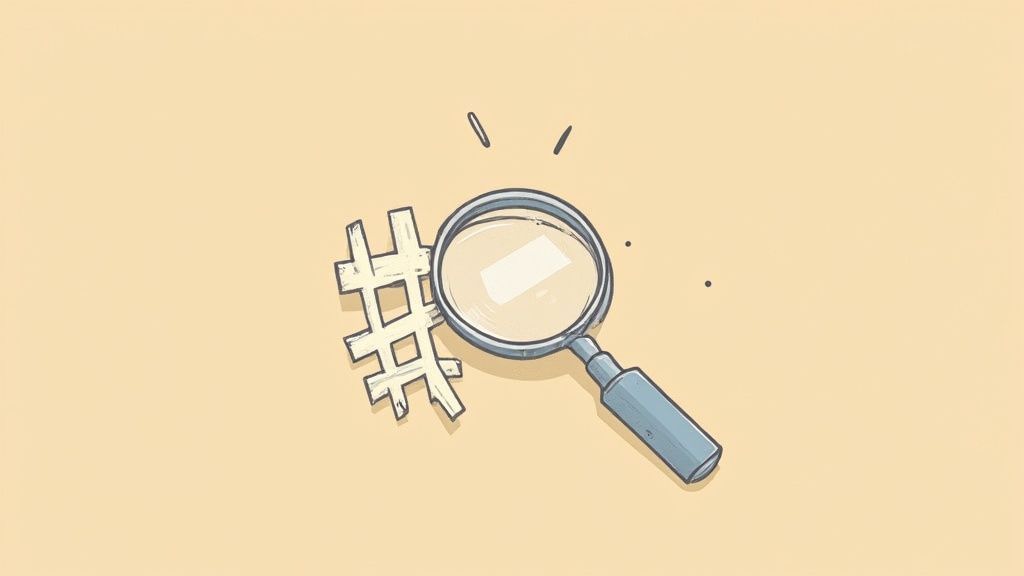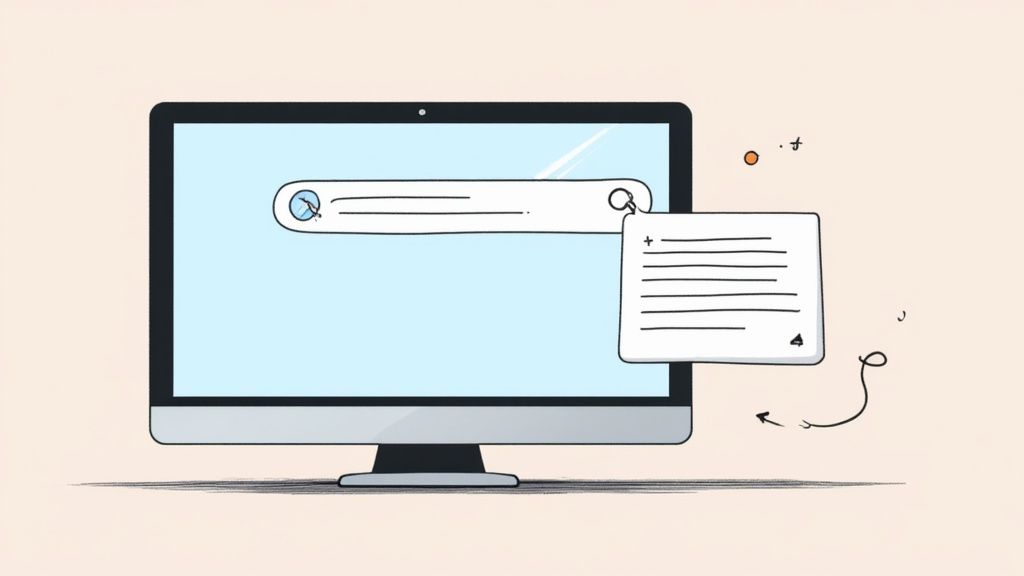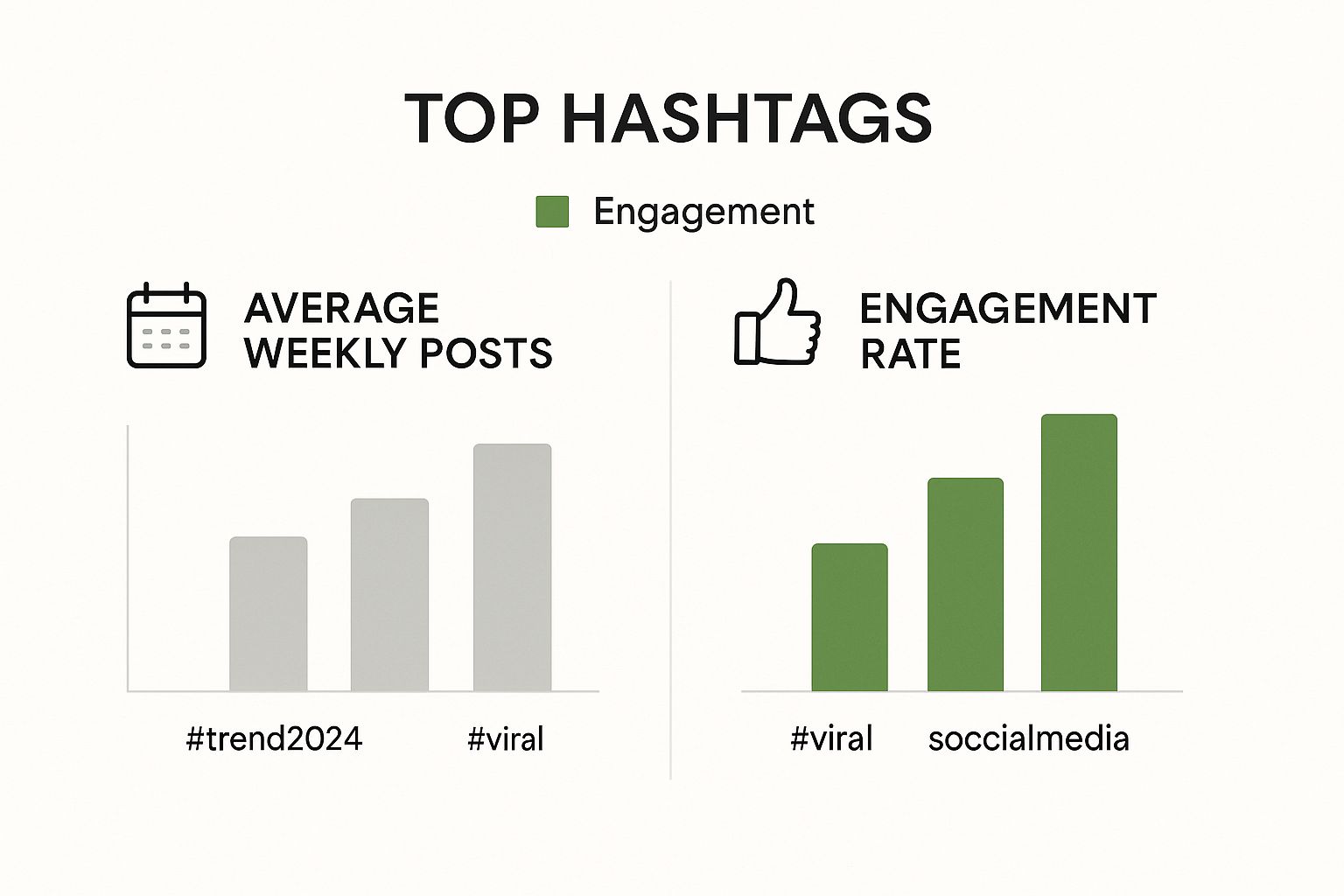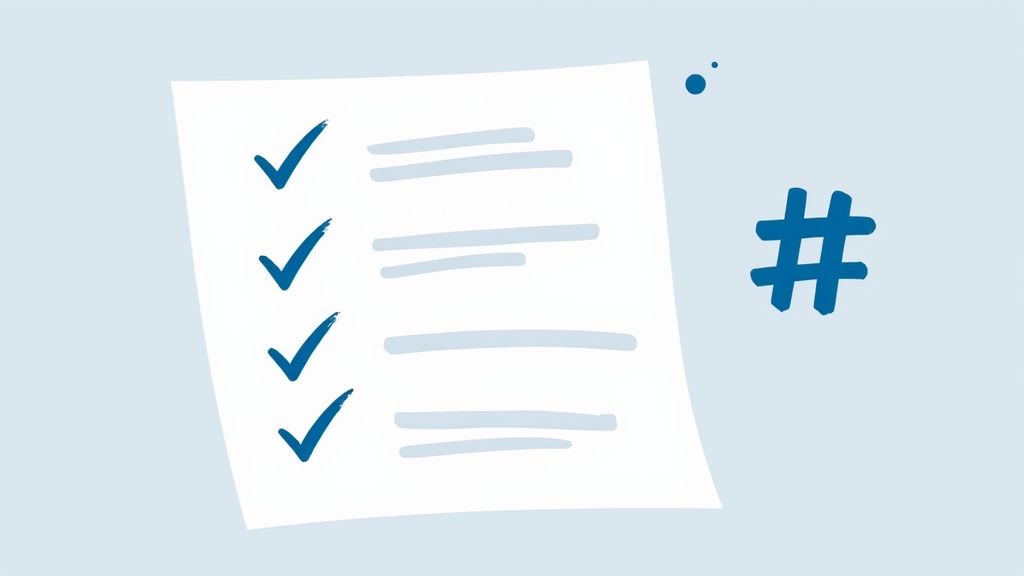How to Find Trending Hashtags That Actually Work
To find the best trending hashtags, you need to look in a few key places. I always recommend a mix of three methods: checking the native tools on platforms like TikTok's Creative Center, using specialized hashtag finder tools, and, of course, keeping a close eye on what your competitors and industry leaders are doing. This way, you get a full picture of what's hot right now and what actually resonates with your audience.
Why Trending Hashtags Are Your Growth Engine

Let's be real—finding the right hashtags can feel like throwing spaghetti at the wall and hoping something sticks. You spend hours crafting the perfect post, only to see it get buried in the endless scroll. But what if hashtags could be less of a chore and more of a secret weapon for growth?
That's exactly what trending hashtags are. They're not just random popular tags; they're your express lane to audiences who haven't met you yet.
Tapping into Real-Time Conversations
Evergreen hashtags like #motivation or #foodie have their place, but they're incredibly broad. Trending hashtags are different. They're tied to what's happening right now—a new meme, a cultural moment, a challenge, or breaking news.
Using them means you're not just posting; you're joining an active, vibrant conversation people are already searching for and engaging with. It's the difference between shouting into an empty room and walking into a party already in full swing.
This simple change can make a huge difference. Research shows that posts with trending hashtags can reach 42% more non-follower accounts. That's a massive boost in discoverability. You can read more about these stats on Recurpost if you want to dig deeper. It’s not just about getting more eyeballs; it's about getting the right ones.
Key Takeaway: Trending hashtags are your ticket to join the conversations your target audience is already having. It’s about being relevant in the moment.
Building Your Digital Presence
Consistently using the right trending hashtags isn't just about a one-off viral post. It builds momentum. When the algorithm sees your content is resonating within a trend, it starts to trust you, showing your future posts to even more people. It’s a powerful cycle that helps you:
- Boost real engagement from people who genuinely care about the topic.
- Show you’re in the know, building your credibility as an expert in your field.
- Grow your community by attracting followers who share a common interest.
Learning how to spot and use trending hashtags is about getting in sync with what people are passionate about at this very moment. It shifts your strategy from just broadcasting content to actively participating in culture, making you far more visible and effective.
Using Native Platform Tools to Spot Trends

You don't always need a sophisticated, paid tool to find great hashtags. Sometimes, the best starting point is right under your nose—built directly into the social media apps you use every day. Think of these native features as your direct line to what a platform's algorithm is prioritizing at that very moment.
Tapping into what’s already buzzing on TikTok, Instagram, or X (the platform formerly known as Twitter) gives you a live look at what people are actually talking about and engaging with.
Decoding Instagram Search and Explore
Your first port of call on Instagram should be the search bar. It’s more powerful than you might think. When you start typing a keyword relevant to your niche—say, #localbakery—Instagram immediately auto-suggests a whole list of related hashtags, complete with post counts. This is pure gold.
You'll see a mix of volumes. A tag with millions of posts is obviously popular, but it's also incredibly crowded. Your content could disappear in seconds. On the other hand, a tag with only a few thousand posts might not have enough eyeballs on it. The magic often happens in that middle ground, where tags have enough traffic to be relevant but aren't so saturated that you can't get noticed.
Pro Tip: Post counts are only half the story. I always tell people to actually click into the hashtags and check out the 'Top' posts. Are the accounts similar to yours in size and style? Is the content genuinely good? This little bit of research tells you if the tag's community is a good fit for your brand.
For instance, a personal trainer might start by searching #fitnessmotivation. They'll quickly see it has hundreds of millions of posts. But the search results will also likely suggest more targeted tags like #onlinepersonaltrainer or a timely one like #workoutathome. A smart strategy is to blend these different types of tags together.
Using TikTok's Built-In Trend Discovery
TikTok is all about trends, and thankfully, they make them pretty easy to find. The platform’s own Creative Center is an absolute treasure trove for anyone creating content. It lays out exactly which hashtags, audio clips, and creators are taking off, and you can even filter everything by your region or industry.
Let's imagine a local boutique is launching a new line of summer dresses. Instead of just guessing with a tag like #newdresses, they can hop into the Creative Center. There, they might discover that a tag like #summeroutfitinspo is actively trending, giving their content a much better shot at being seen.
The key to finding trending hashtags on TikTok is simply to let the platform itself show you what's working.

This ability to move from a broad idea to a specific, high-potential tag is what separates successful posts from the ones that fall flat. Of course, using the right tag is only part of the equation; you also have to post it at the right time. Combining trending tags with optimal timing is crucial, which is why understanding the https://publora.com/blog/best-times-to-post-on-social-media is so important.
On a platform like Instagram, a post's virality often hinges on using these timely, high-volume tags. For example, broad hashtags like #reels (with over 825M uses) and #trending (with over 652M uses) are incredibly popular because they signal to the algorithm that your content is meant for wide discovery.
Picking the Right Hashtag Finder Tool
When you're ready to get serious about hashtags, moving beyond what the platforms offer natively is a game-changer. Dedicated tools give you a real strategic advantage. They don't just spit out popular tags; they dig deep into the data to help you find trending hashtags that will actually connect with your audience.
The key is finding a tool that fits your specific needs and budget.
A lot of people start with free hashtag generators. They're usually web-based, super simple to use, and great for a quick brainstorming session. You pop in a keyword, and boom—you get a list of related tags. But that's usually where it ends. They don't offer the kind of deep analytics you need to build a solid, long-term strategy. You won't know if a hashtag is a flash in the pan or how tough the competition is.
For anyone truly focused on growth, investing in a paid tool is the logical next step. The features you get are on a completely different level.
Going Beyond Basic Suggestions
Paid tools completely change the game. Instead of just a static list, you get a full-blown performance dashboard. This lets you see a hashtag's history, track its current momentum, and understand just how crowded the field is. It's about making informed choices, not just guessing.
Here's what a quality hashtag tool should really offer:
- Trend Analysis: The ability to see if a hashtag's popularity is on the rise, falling off a cliff, or holding steady. This is crucial.
- Competition Score: A metric that tells you how hard it will be for your content to get seen using that tag. Is it a small pond or a massive ocean?
- AI-Powered Recommendations: The smartest tools use AI to look at your profile and content, then suggest personalized hashtags that you actually have a chance of ranking for.
- Performance Tracking: Features that let you monitor how your chosen hashtags are actually performing on your posts. This feedback loop is how you get better.
A great tool doesn't just hand you hashtags; it gives you the intelligence to choose the right hashtags. It's all about finding that sweet spot between high visibility and achievable reach.
This image shows exactly what I mean. It compares the post volume of a few tags against their actual engagement rates. You can see how bigger isn't always better.

The data here is pretty clear. A less-used but highly relevant tag like #smallbusinessowner can drive much more meaningful engagement than a completely oversaturated tag like #viral.
Finding the Right Fit: A Comparison
Choosing a tool often comes down to who it was built for. Some are perfect for solo creators with straightforward interfaces and affordable plans. Others are built for agencies, packed with features for managing multiple clients and creating in-depth reports.
To help you decide, here’s a quick comparison of some of the top players in the market.
Comparison of Top Hashtag Finder Tools
This table compares the key features, pricing models, and best-use scenarios for leading hashtag discovery and analytics tools to help you choose the right one for your needs.
| Tool Name | Key Feature | Pricing | Best For |
|---|---|---|---|
| Publora | AI content & hashtag suggestions integrated with a scheduler. | Subscription-based | All-in-one content creators and marketers. |
| Hashtagify | In-depth trend analysis and competitor tracking. | Freemium/Subscription | Researchers and data-driven strategists. |
| RiteTag | Real-time color-coded hashtag suggestions based on live data. | Subscription (part of RiteKit suite) | Social media managers who need instant feedback. |
| Flick | AI-powered suggestions with detailed analytics and tracking. | Subscription-based | Instagram-focused creators and brands. |
Each tool has its strengths. A TikTok-focused tool will probably prioritize trending sounds and challenges, while an Instagram tool might offer deeper analytics for Reels and Stories. A platform like Publora is fantastic because it rolls everything into one workflow—it uses AI to help you write posts and find the right hashtags, all inside its content scheduler. It’s a massive time-saver.
Ultimately, the best tool is the one that slots right into your creative process. It should give you clear, actionable insights that turn the guesswork of finding hashtags into a reliable system for growth.
Learning from Competitors and Industry Leaders
 Why reinvent the wheel? One of the fastest ways to find hashtags that actually work is to see what your competitors and industry leaders are already doing successfully. This isn't about blindly copying them; it's smart reconnaissance.
Why reinvent the wheel? One of the fastest ways to find hashtags that actually work is to see what your competitors and industry leaders are already doing successfully. This isn't about blindly copying them; it's smart reconnaissance.
Think of it this way: the top players have already done a lot of the heavy lifting. By studying their strategy, you get a free peek into what's resonating with the very audience you’re trying to reach.
Identifying Top Performers in Your Niche
First things first, you need to know who to watch. Don't just zero in on your direct competitors. A great list will include a mix of accounts your ideal customer already follows and trusts.
I always recommend building a "watch list" that includes:
- Direct Competitors: Obvious, but essential. These are the brands offering similar products or services.
- Industry Influencers: The creators and thought leaders everyone in your space looks up to.
- Aspirational Brands: Companies you admire who are a few steps ahead but serve a similar audience.
Once you have your list, dive into their recent posts. I'm not talking about a quick scroll—I mean really look at their most popular content. Pinpoint the posts with the most likes, comments, and shares. That's where the hashtag gold is buried.
Deconstructing Their Hashtag Strategy
Now, don't just grab a handful of hashtags and call it a day. The real magic happens when you analyze why certain tags were used. You need to look for the patterns behind their choices.
Notice how the best accounts never rely on just one type of hashtag. They’re masters at blending different kinds to get the best of all worlds: maximum reach and pinpoint relevance.
For example, I recently saw a local coffee shop post a picture of their new seasonal latte. They didn't just use #coffee. Their post included a mix like #fallvibes (a broad, trending tag), #coffeeroasters (a niche community tag), #dallascoffee (a location tag), and #pumpkinspiceeverything (a fun, timely tag).
Key Insight: The pros use a "hashtag stacking" method. They layer broad, popular tags with super-specific community tags to draw in both a wide audience and a highly engaged, targeted one.
This layered approach gives their content multiple shots at being discovered. The big, popular tags catch the casual scrollers, while the niche tags pull in the die-hard fans who are much more likely to comment and share.
As you analyze a competitor's post, try to categorize their hashtags. What's their ratio of broad tags to niche tags? Are they using a branded hashtag to encourage user-generated content?
By reverse-engineering what's already working for the top accounts, you can build a powerful, proven hashtag list without all the guesswork. It's an immediate competitive advantage.
How to Build a Smarter Hashtag Strategy
Finding a trending hashtag is just the start. The real magic happens when you know exactly what to do with it. A smart strategy isn't about jumping on every popular tag you see; it's about building a system that consistently gets your content in front of the right people.
One of the most effective approaches I've seen is called "hashtag stacking." Think of it like building a balanced investment portfolio. You don't put all your money into one stock, right? Same idea here. Instead of relying on one type of tag, you mix and match different kinds to get the best of both worlds: broad reach and targeted engagement.
The Art of Hashtag Stacking
This is where you strategically combine a few different types of hashtags in a single post. It’s the difference between casting a single fishing line and using a wide net with just the right bait to attract the fish you actually want to catch.
Here’s what a solid hashtag stack usually looks like:
- Broad, High-Traffic Tags: These are the big, popular ones everyone knows, like
#fallfashionor#digitalmarketing. They can give your content a shot at massive visibility, but you’re also competing with a ton of other posts. It's a long shot, but worth taking. - Niche, Community Tags: These are much more specific to your field or audience—think
#handmadepotteryor#chicagofoodie. The audience is smaller, but they're way more engaged and genuinely interested in what you’re posting. - Branded Tags: This is your own unique tag, like our
#PubloraTips. It’s fantastic for building a community around your brand and makes it easy to find all the great content your followers create.
By layering these together in one post, you’re covering all your bases. You’re reaching for the stars with the broad tags while grounding your post in a relevant community with the niche ones.
Platform-Specific Best Practices
Now, how you use your hashtag stack changes completely depending on the platform. What crushes it on Instagram can fall flat on TikTok, so you can't just copy and paste.
On Instagram, the general consensus is that 8-15 well-researched hashtags is the sweet spot. You can use up to 30, but quality always trumps quantity. Jamming 30 tags into a post can look spammy and just waters down your message. I usually tuck them at the very end of the caption or drop them in the first comment to keep the post looking clean.
TikTok is a totally different beast. It’s all about being brief and hyper-relevant. Stick to just 3-5 highly targeted hashtags. The algorithm is incredibly smart, so a few precise tags will do more for you than a dozen random ones. With over 1 billion monthly active users, TikTok has shown that a focused strategy pays off. Sure, a mega-tag like #fyp has nearly 35 trillion views, but real success often comes from nailing your niche.
Key Takeaway: A winning strategy is less about finding tags and more about how you use them. Always adjust your hashtag count and where you place them to fit the platform’s algorithm and what its users expect.
Getting your hashtags right is also a huge piece of any good influencer marketing strategy.
The goal here is to create a repeatable system. You can even build saved lists of hashtags for your main content themes and then tweak them for each new post. This intentional approach is a cornerstone of any effective social media content strategy. From there, just keep an eye on what’s working, see which tags bring in the best engagement, and keep refining. That's how you turn hashtags from a guessing game into a reliable tool for growth.
Your Top Hashtag Questions, Answered
Once you start using hashtags, you’ll quickly run into some common questions. Moving from knowing about hashtags to actually using them effectively can feel like a big leap. Let's clear up a few of the most frequent sticking points. Nailing these details will make all the difference.
A question I hear all the time is, "Can I just copy and paste the same hashtags on every post?" It seems like a smart shortcut, but it's a habit you'll want to break. Platforms, especially Instagram, can see that repetitive behavior as spammy, and you might find your posts getting less visibility, not more.
A much better way to handle this is to build a few core hashtag lists based on your main content themes. For instance, if you're a fitness coach, you might have lists for #HIITWorkouts, #YogaForBeginners, and #NutritionTips. When you post, grab the most relevant list and then add 2-3 fresh, ultra-specific tags that describe that exact video or photo. This keeps your strategy fresh and tells the algorithm your content is relevant.
How Many Hashtags Should I Actually Use?
There's no magic number here. The right amount of hashtags really comes down to which platform you're on.
For Instagram, the sweet spot tends to be somewhere between 8 and 15 hashtags. You can use up to 30, but stuffing your posts with tags doesn't guarantee better results. I've found that a thoughtful mix of broad and niche tags almost always performs better than just maxing out the count.
Over on TikTok, the game is completely different. Keep it lean and mean with just 3-5 highly relevant hashtags. TikTok’s algorithm is incredibly good at figuring out what your content is about, so a few precise tags are far more powerful than a long list of generic ones.
My Two Cents: Don't just follow a formula. The only way to know for sure what works for your brand is to experiment. Try using 5 hashtags on one post and 15 on the next. Watch your analytics. See what moves the needle on engagement.
This targeted approach helps get your content in front of people who will actually care, which is a critical first step if you want to increase your social media followers.
Trending vs. Popular Tags: What's the Difference?
This is another area where people get tripped up. "Trending" and "popular" hashtags sound similar, but they serve very different purposes. Knowing when to use each one can dramatically affect your reach.
- Popular Hashtags: Think of these as the giants—they're the evergreen tags like
#foodieor#fitnessthat have millions of posts. They're always active, which is great, but it also means your content is a tiny fish in a massive ocean. - Trending Hashtags: These are tags that explode in popularity over a short time. They're almost always tied to something happening right now—a news story, a viral challenge, a meme, or a holiday.
While popular tags can give you a slow and steady trickle of views, trending tags are where the real opportunity for discovery lies. Social platforms want to show users what's hot at this very moment, so jumping on a trend gives you a fantastic shot at riding a wave of attention. The best strategies I've seen use a healthy mix of both.
Ready to stop guessing and start growing? Publora provides AI-powered tools to help you find the perfect hashtags, schedule content, and manage all your social accounts from one place. Start your free trial today and save over 10 hours a week.
